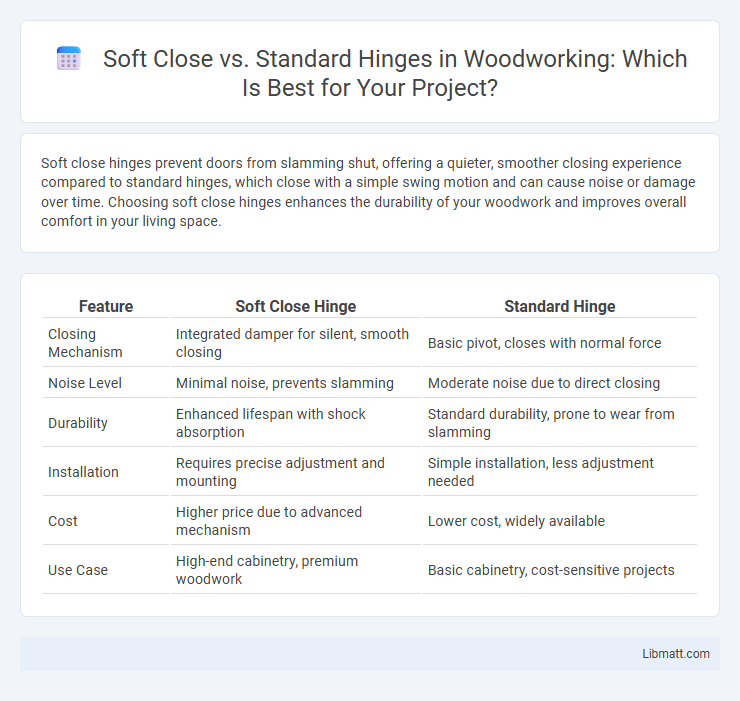Soft close hinges prevent doors from slamming shut, offering a quieter, smoother closing experience compared to standard hinges, which close with a simple swing motion and can cause noise or damage over time. Choosing soft close hinges enhances the durability of your woodwork and improves overall comfort in your living space.
Table of Comparison
| Feature | Soft Close Hinge | Standard Hinge |
|---|---|---|
| Closing Mechanism | Integrated damper for silent, smooth closing | Basic pivot, closes with normal force |
| Noise Level | Minimal noise, prevents slamming | Moderate noise due to direct closing |
| Durability | Enhanced lifespan with shock absorption | Standard durability, prone to wear from slamming |
| Installation | Requires precise adjustment and mounting | Simple installation, less adjustment needed |
| Cost | Higher price due to advanced mechanism | Lower cost, widely available |
| Use Case | High-end cabinetry, premium woodwork | Basic cabinetry, cost-sensitive projects |
Introduction to Cabinet Hinges: Soft Close vs Standard
Cabinet hinges serve as essential hardware for door functionality, with soft close and standard hinges being the two primary types used in woodwork. Soft close hinges feature built-in dampers that slow door closing, preventing slamming and reducing wear on cabinets. Standard hinges operate without this mechanism, allowing doors to close freely but often resulting in louder impacts and quicker hardware deterioration.
How Soft Close Hinges Work
Soft close hinges incorporate hydraulic mechanisms that control the door's closing speed, preventing it from slamming shut and reducing noise. These hinges use dampers to slow the motion during the last few degrees of closure, ensuring a smooth and gentle shut. Unlike standard hinges, which rely solely on metal pivot points, soft close hinges enhance durability by minimizing impact stress on cabinets and doors.
Mechanism of Standard Hinges
Standard hinges in woodwork operate through a simple pivot mechanism with two plates connected by a pin, allowing the door or panel to swing open and closed. These hinges lack damping features, which results in doors closing with natural momentum and sometimes causing noise or impact against the frame. The basic metal construction and absence of integrated soft-close technology distinguish standard hinges from their soft-close counterparts, emphasizing straightforward functionality over controlled movement.
Benefits of Soft Close Hinges
Soft close hinges provide smooth, controlled closing that prevents doors or cabinets from slamming, reducing wear and tear on woodwork. They enhance durability by minimizing impact damage and noise, promoting a quieter and more refined environment. Installation of soft close hinges improves user experience by offering gentle operation, which is especially beneficial in high-traffic areas or households with children.
Advantages of Standard Hinges
Standard hinges offer durability and ease of installation, making them a reliable choice for woodwork projects. They provide a straightforward mechanism that allows you to quickly open and close doors without any specialized features, simplifying maintenance and replacements. Their low cost compared to soft close hinges makes them an economical option for many cabinetry and furniture applications.
Installation Process: Soft Close vs Standard Hinges
Soft close hinges require precise alignment during installation to ensure the damping mechanism functions properly, often involving additional screws and adjustment settings. Standard hinges offer a simpler installation process with basic mounting and fewer adjustment steps, making them easier for DIY projects. Your choice impacts installation time and the need for fine-tuning to achieve smooth door operation.
Cost Comparison: Soft Close and Standard Hinges
Soft close hinges typically cost between $10 to $20 per piece, making them more expensive than standard hinges, which generally range from $2 to $8 each. The higher price of soft close hinges reflects their integrated damping mechanism that prevents cabinet doors from slamming, extending the longevity of woodwork and reducing noise. Standard hinges offer a budget-friendly option but lack the advanced functionality and noise reduction benefits found in soft close models.
Durability and Maintenance Differences
Soft close hinges feature hydraulic dampers that prevent slamming, reducing wear and extending the lifespan of cabinet doors, while standard hinges lack this mechanism and often experience quicker degradation due to repeated impact. Maintenance for soft close hinges is generally minimal, requiring occasional lubrication to ensure smooth functioning, whereas standard hinges may demand more frequent adjustments and replacements due to loosening screws and increased friction. The enhanced durability of soft close hinges results in lower long-term maintenance costs compared to the standard hinge option commonly used in woodwork.
Best Applications for Each Hinge Type
Soft close hinges excel in kitchen cabinets and bathroom vanities where quiet, smooth closing prevents slamming and damage, enhancing durability and user experience. Standard hinges suit furniture or cabinetry requiring frequent, quick access without the need for noise reduction, offering cost-effective, robust support in workshops or utility areas. Choosing between soft close and standard hinges depends on balancing noise control, budget, and usage frequency in woodwork projects.
Which Hinge Should You Choose?
Choosing between soft close and standard hinges depends on your preferences for noise reduction and durability in woodwork. Soft close hinges prevent doors from slamming shut, extending the lifespan of your cabinetry and providing a quieter, more refined experience. If your priority is cost-effectiveness and simplicity, standard hinges offer reliable functionality without the added mechanism of soft close technology.
Soft close vs Standard hinge (woodwork) Infographic

 libmatt.com
libmatt.com